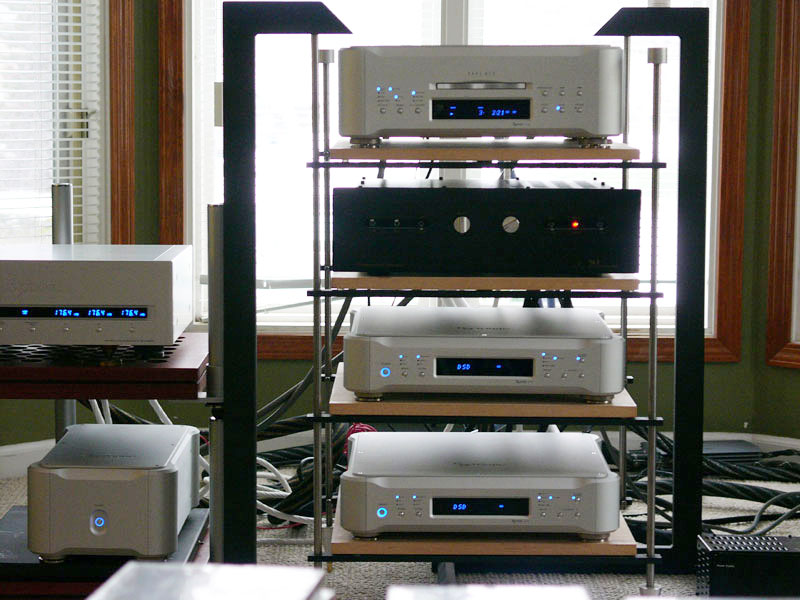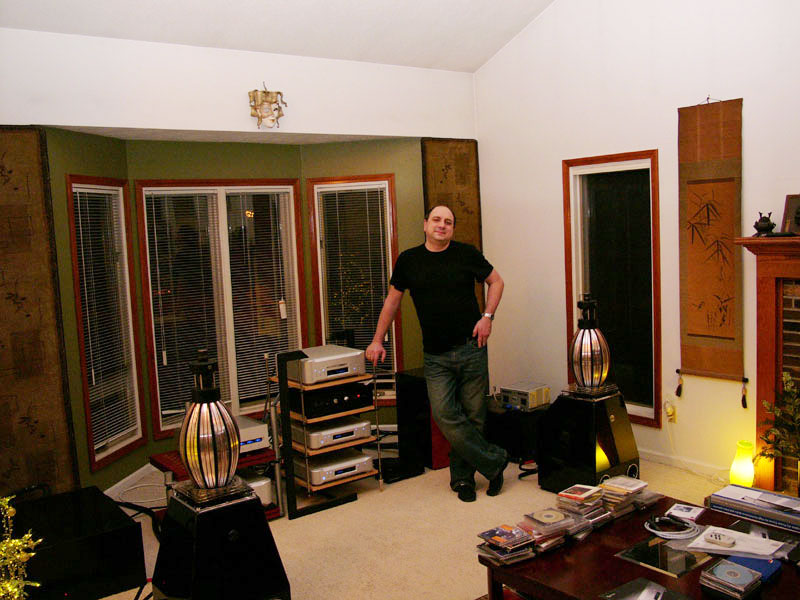 May 2009
Japan Meets Germany in Michigan
"Esoteric has a new top-of-the-line
transport and mono DACs." That is what SoundStage! editor Marc Mickelson told
me sometime late last year. "That's great," I thought, "but I don't have
any plans to go to CES this year." The stress of a show environment rarely leads to
good sound, and almost never leads to enjoyable listening. When Marc told me that the
system with the new Esoteric digital gear was being demonstrated by a dealer not terribly
far from me, the prospect seemed somewhat more appealing, but I still dreaded hours of
listening to lifeless performances impeccably captured on discs that are the staples of
audiophile demo material. Marc had one more thing to say, "The dealer is a concert
pianist, and a professor of piano at Michigan State University." OK, then I
was interested.
George Vatchnadze, the pianist, runs Kyomi Audio
out of his beautiful home near East Lansing, Michigan, about three hours from my home
south and further east. One thing that sets George apart from most other people in this
industry -- sellers, reviewers, and buyers alike -- is that he spends more time in a
typical week listening to live music than to recorded music. Whether or not you like your
system to sound the way that George likes his to sound, there can be no doubt that he has
an intimate knowledge of the real thing. George is somewhat interested in the equipment he
sells, but he is more interested in the sound that it produces. That may seem obvious to
you and it is to me, but it is a notion that seems to elude many dealers. It just so
happens that the equipment used to generate such sound is easily the object of an
audiophile's lust.

The electronics for the Kyomi Audio demo system: (Top
to bottom) an Esoteric P-01VU transport, a Convergent Audio SL-1
Ultimate Mk 2 tube preamp, and a pair of Esoteric D-01VU mono digital-to-analog
converters. To the left are an Esoteric
G-0Rb rubidium master clock and the power supply for the transport.
On the day that I heard his demonstration system,
its source was the Esoteric P-01VU transport ($32,000) feeding a pair of Esoteric D-01VU
mono digital-to-analog converters ($32,000 per pair), all fresh from manufacture in Japan.
The two were synchronized by the Esoteric G-0Rb rubidium master clock ($16,000). This
illustrious front-end fed a Convergent Audio SL-1 Ultimate Mk 2 tube preamplifier ($9950
with phono stage), whose output ran to a pair of German-made Symphonic Line Kraft 400 mono
amplifiers ($36,000 per pair when still available in the 1990s), which deliver a whopping
450W of pure class-A power. The current top-of-the-Symphonic Line amps are the Kraft 300
monoblocks ($48,900 per pair). Speakers were the stunning omnidirectional MBL 101E Mk II
Radiastrahler Reference ($59,990 per pair) also from Deutschland. These speakers
present a relatively low-impedance load that can be challenging to some amplifiers, but
450W of solid-state power were clearly up to the task. Just in case the bass output of the
MBL speakers wasn't sufficient -- which it certainly was -- an Acustik Lab Stella Novus
subwoofer ($12,000) could be seamlessly integrated into the aural picture.
All of the equipment, with the exception of the
monoblocks, was supported by a pARTicular Novus semi-suspended rack. Cabling was entirely
from Stealth Audio: Indra ($6500 meter per pair) and Nanofiber ($2600 meter per pair)
interconnects, Varidig Sextet AES/EBU digital cables ($3600 each), and Dream speaker
cables ($10,800 per eight-foot pair). Power was provided to the equipment through a
separate circuit with its own grounding rods, the final distance covered by Stealth Dream
power cords ($3200 each) for each component.
As is said of good composers of modern music,
"You first must know the rules in order to break them." George knows the theory
behind properly placing an audio system in a room, but violates many of its principles
because "It just sounds better this way." His 22'W x 26'L listening room opens
onto a large kitchen. Its cathedral ceiling slopes from 9 feet to 17 feet high. For those
keeping score, that's 7436 cubic feet plus the kitchen -- a tremendous volume to fill with
sound in a home environment. The cards would seem to be further stacked against audio
reproduction, as George has placed the speakers in front of an area behind which is a bay
window.

George Vatchnadze of Kyomi Audio stands amidst his
internationally flavored audio system.
One might think that compromises in favor of
décor were made by observing how the system does not seem to intrude upon the living
space, but George says that he's tried other arrangements that didn't work nearly so well
sonically. He demonstrated that even something so seemingly obvious as pulling curtains
across the window had a detrimental effect on the sound, which is akin to drawing a
curtain across the stage, causing the high frequencies to lose much of their sparkle. So
much for theory. For an audio dealer, such a setup is also useful in persuading clients
that an audio system can work within their home, rather than that they must find a home
for their audio system.
All thoughts of there having been compromises
vanished when music started emanating from the silvery sculptures that are the MBL
speakers. This event was to be an audio demonstration, for me as well as for others. Was I
blown away by the sound? No. Rather, I was seduced by its ease, fluidity, and
spaciousness. Often these virtues come at the expense of the traditional audiophile
priorities of frequency extension, detail retrieval, and dynamic headroom. In this case,
however, the sound did not win out over the music, and the music did not trump the sound.
They existed together in perfect harmony -- pun intended. I marveled at how George's large
listening space gave the music room to breathe in a natural way. When the volumes were
high, the room could not be overloaded. More impressively, when the volumes were low, the
sound wasn't lost.
George's setup, unlike most, encourages group
listening. Even when sitting outside the sweet spot, I found there were no apparent tonal
shifts, and there was still some sense of the spatial relationship between performers --
both of these things owing to the omnidirectional radiation pattern of the MBL speakers.
George confessed to me that his favorite listening spot was to the side of the triangle
created between the speakers and the listening couch. I'm not sure that I would choose
that spot from which to listen, but I wholeheartedly agreed that it sounded just as
musically right.
After a few solid hours of listening, we
adjourned to a local steakhouse for a great meal, with much wine and heated conversation
about the nature of digital jitter, among other topics. Out of this conversation came the
idea to perform a little experiment. This article is not meant to be a product review, but
the experiment was interesting enough to merit description.
During the afternoon, the Esoteric transport and
digital-to-analog converters had been receiving their clock signals from the G-0Rb
rubidium master clock. I was curious to hear the difference when that component was
removed. The good people at Esoteric would, I'm sure, like me to tell you that the
difference would be night and day. It wasn't, although it was clearly audible. The sound
lost the tiniest fraction of that superb flow to which I referred earlier. I may not have
missed it if I hadn't heard the system the first way, but an unfortunate reality in audio
is that once you've heard what is possible your expectations are forever raised. Without
the master clock, the P-01VU transport and D-01VU DACs only delivered the second-best
digital sound that I've heard. Some confusion in the reconfiguration even led to an
unintentional double-blind test, so I can say that I am convinced of the value of the
master clock for those who can afford it.
The Esoteric digital combo also has the ability
to stream the digital data over a proprietary FireWire connection, and we all had some
curiosity about using this facility. Setting up the system in this way was substantially
inferior to using the dual AES/EBU connections. Frequency extension was diminished in both
high and low, and the soundstage collapsed. More troubling, the music seemed to lose its
rhythm. I don't mean that the musicians were now playing at the wrong times -- that's
impossible -- but it was similar to the difference between hearing a group of professional
musicians who are not accustomed to playing with each other and a group that has been
together for years. The latter is noticeably tighter than the former, even if the beat
hasn't really changed. Since we did have the president and designer of Stealth Audio
Cables with us, I suggested that a higher-quality FireWire cable may make a difference.
One was not available, but we did have some generic AES/EBU cables. While these did sound
inferior to the Stealth cables – sadly, as I'm not one to like paying so much for
cables -- much of the performance was restored.
The moral of this story is that the means of
getting the digital data from one place to another is a crucial aspect of performance. I
should point out that only an extraordinarily resolving system is capable of demonstrating
such differences.
What about the music? Well, there were some
standard test discs played, which led to impressive sound in this or that respect, but
most of our listening time was devoted to real music. Some of the discs were ones that I
had brought along, but many others were those that George had chosen for their musical as
well as sonic virtues. Probably the most surprising was Horowitz in Moscow
(Deutsche Grammophon DGG 4194992), which was not only musically involving but captured the
piano and hall in as natural a manner as I have heard from any recording.
This wasn't CES -- it was much better: hosted by
a musician with music as the centerpiece. What audiophile would ask for more?
...S. Andrea Sundaram
s_andrea@soundstage.com
|

